[English] 日本語
 Yorodumi
Yorodumi- EMDB-27743: Cryo-EM structure of RIG-I bound to the end of p3SLR30 (+AMPPNP) -
+ Open data
Open data
- Basic information
Basic information
| Entry |  | |||||||||
|---|---|---|---|---|---|---|---|---|---|---|
| Title | Cryo-EM structure of RIG-I bound to the end of p3SLR30 (+AMPPNP) | |||||||||
 Map data Map data | Cryo-EM structure of protein-RNA complex 7 | |||||||||
 Sample Sample |
| |||||||||
| Function / homology |  Function and homology information Function and homology informationregulation of type III interferon production / RIG-I signaling pathway / positive regulation of myeloid dendritic cell cytokine production / OAS antiviral response / detection of virus / NF-kB activation through FADD/RIP-1 pathway mediated by caspase-8 and -10 / positive regulation of response to cytokine stimulus / positive regulation of granulocyte macrophage colony-stimulating factor production /  pattern recognition receptor activity / TRAF6 mediated IRF7 activation ...regulation of type III interferon production / RIG-I signaling pathway / positive regulation of myeloid dendritic cell cytokine production / OAS antiviral response / detection of virus / NF-kB activation through FADD/RIP-1 pathway mediated by caspase-8 and -10 / positive regulation of response to cytokine stimulus / positive regulation of granulocyte macrophage colony-stimulating factor production / pattern recognition receptor activity / TRAF6 mediated IRF7 activation ...regulation of type III interferon production / RIG-I signaling pathway / positive regulation of myeloid dendritic cell cytokine production / OAS antiviral response / detection of virus / NF-kB activation through FADD/RIP-1 pathway mediated by caspase-8 and -10 / positive regulation of response to cytokine stimulus / positive regulation of granulocyte macrophage colony-stimulating factor production /  pattern recognition receptor activity / TRAF6 mediated IRF7 activation / cellular response to exogenous dsRNA / response to exogenous dsRNA / cytoplasmic pattern recognition receptor signaling pathway / positive regulation of interferon-alpha production / antiviral innate immune response / TRAF6 mediated NF-kB activation / bicellular tight junction / pattern recognition receptor activity / TRAF6 mediated IRF7 activation / cellular response to exogenous dsRNA / response to exogenous dsRNA / cytoplasmic pattern recognition receptor signaling pathway / positive regulation of interferon-alpha production / antiviral innate immune response / TRAF6 mediated NF-kB activation / bicellular tight junction /  regulation of cell migration / positive regulation of defense response to virus by host / positive regulation of interferon-beta production / Negative regulators of DDX58/IFIH1 signaling / positive regulation of interleukin-8 production / response to virus / DDX58/IFIH1-mediated induction of interferon-alpha/beta / ISG15 antiviral mechanism / ruffle membrane / positive regulation of interleukin-6 production / SARS-CoV-1 activates/modulates innate immune responses / positive regulation of DNA-binding transcription factor activity / Ovarian tumor domain proteases / regulation of cell migration / positive regulation of defense response to virus by host / positive regulation of interferon-beta production / Negative regulators of DDX58/IFIH1 signaling / positive regulation of interleukin-8 production / response to virus / DDX58/IFIH1-mediated induction of interferon-alpha/beta / ISG15 antiviral mechanism / ruffle membrane / positive regulation of interleukin-6 production / SARS-CoV-1 activates/modulates innate immune responses / positive regulation of DNA-binding transcription factor activity / Ovarian tumor domain proteases /  actin cytoskeleton / positive regulation of tumor necrosis factor production / actin cytoskeleton / positive regulation of tumor necrosis factor production /  double-stranded RNA binding / double-stranded RNA binding /  gene expression / TRAF3-dependent IRF activation pathway / gene expression / TRAF3-dependent IRF activation pathway /  double-stranded DNA binding / defense response to virus / double-stranded DNA binding / defense response to virus /  RNA helicase activity / RNA helicase activity /  single-stranded RNA binding / Ub-specific processing proteases / single-stranded RNA binding / Ub-specific processing proteases /  RNA helicase / RNA helicase /  ribonucleoprotein complex / ribonucleoprotein complex /  innate immune response / innate immune response /  ubiquitin protein ligase binding / positive regulation of gene expression / GTP binding / SARS-CoV-2 activates/modulates innate and adaptive immune responses / ubiquitin protein ligase binding / positive regulation of gene expression / GTP binding / SARS-CoV-2 activates/modulates innate and adaptive immune responses /  ATP hydrolysis activity / positive regulation of transcription by RNA polymerase II / zinc ion binding / ATP hydrolysis activity / positive regulation of transcription by RNA polymerase II / zinc ion binding /  ATP binding / identical protein binding / ATP binding / identical protein binding /  cytosol / cytosol /  cytoplasm cytoplasmSimilarity search - Function | |||||||||
| Biological species |   Homo sapiens (human) Homo sapiens (human) | |||||||||
| Method |  single particle reconstruction / single particle reconstruction /  cryo EM / Resolution: 3.3 Å cryo EM / Resolution: 3.3 Å | |||||||||
 Authors Authors | Wang W / Pyle AM | |||||||||
| Funding support |  United States, 2 items United States, 2 items
| |||||||||
 Citation Citation |  Journal: Mol Cell / Year: 2022 Journal: Mol Cell / Year: 2022Title: The RIG-I receptor adopts two different conformations for distinguishing host from viral RNA ligands. Authors: Wenshuai Wang / Anna Marie Pyle /  Abstract: RIG-I is an essential innate immune receptor for detecting and responding to infection by RNA viruses. RIG-I specifically recognizes the unique molecular features of viral RNA molecules and ...RIG-I is an essential innate immune receptor for detecting and responding to infection by RNA viruses. RIG-I specifically recognizes the unique molecular features of viral RNA molecules and selectively distinguishes them from closely related RNAs abundant in host cells. The physical basis for this exquisite selectivity is revealed through a series of high-resolution cryo-EM structures of RIG-I in complex with host and viral RNA ligands. These studies demonstrate that RIG-I actively samples double-stranded RNAs in the cytoplasm and distinguishes them by adopting two different types of protein folds. Upon binding viral RNA, RIG-I adopts a high-affinity conformation that is conducive to signaling, while host RNA induces an autoinhibited conformation that stimulates RNA release. By coupling protein folding with RNA binding selectivity, RIG-I distinguishes RNA molecules that differ by as little as one phosphate group, thereby explaining the molecular basis for selective antiviral sensing and the induction of autoimmunity upon RIG-I dysregulation. | |||||||||
| History |
|
- Structure visualization
Structure visualization
| Supplemental images |
|---|
- Downloads & links
Downloads & links
-EMDB archive
| Map data |  emd_27743.map.gz emd_27743.map.gz | 25.3 MB |  EMDB map data format EMDB map data format | |
|---|---|---|---|---|
| Header (meta data) |  emd-27743-v30.xml emd-27743-v30.xml emd-27743.xml emd-27743.xml | 16.1 KB 16.1 KB | Display Display |  EMDB header EMDB header |
| FSC (resolution estimation) |  emd_27743_fsc.xml emd_27743_fsc.xml | 6.9 KB | Display |  FSC data file FSC data file |
| Images |  emd_27743.png emd_27743.png | 59.3 KB | ||
| Masks |  emd_27743_msk_1.map emd_27743_msk_1.map | 27 MB |  Mask map Mask map | |
| Others |  emd_27743_half_map_1.map.gz emd_27743_half_map_1.map.gz emd_27743_half_map_2.map.gz emd_27743_half_map_2.map.gz | 20.6 MB 20.6 MB | ||
| Archive directory |  http://ftp.pdbj.org/pub/emdb/structures/EMD-27743 http://ftp.pdbj.org/pub/emdb/structures/EMD-27743 ftp://ftp.pdbj.org/pub/emdb/structures/EMD-27743 ftp://ftp.pdbj.org/pub/emdb/structures/EMD-27743 | HTTPS FTP |
-Related structure data
| Related structure data |  8dvrMC  7tnxC 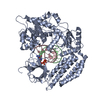 7tnyC 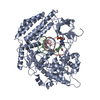 7tnzC  7to0C 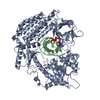 7to1C  7to2C 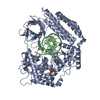 8dvsC  8dvuC M: atomic model generated by this map C: citing same article ( |
|---|---|
| Similar structure data | Similarity search - Function & homology  F&H Search F&H Search |
- Links
Links
| EMDB pages |  EMDB (EBI/PDBe) / EMDB (EBI/PDBe) /  EMDataResource EMDataResource |
|---|---|
| Related items in Molecule of the Month |
- Map
Map
| File |  Download / File: emd_27743.map.gz / Format: CCP4 / Size: 27 MB / Type: IMAGE STORED AS FLOATING POINT NUMBER (4 BYTES) Download / File: emd_27743.map.gz / Format: CCP4 / Size: 27 MB / Type: IMAGE STORED AS FLOATING POINT NUMBER (4 BYTES) | ||||||||||||||||||||
|---|---|---|---|---|---|---|---|---|---|---|---|---|---|---|---|---|---|---|---|---|---|
| Annotation | Cryo-EM structure of protein-RNA complex 7 | ||||||||||||||||||||
| Voxel size | X=Y=Z: 1.068 Å | ||||||||||||||||||||
| Density |
| ||||||||||||||||||||
| Symmetry | Space group: 1 | ||||||||||||||||||||
| Details | EMDB XML:
|
-Supplemental data
-Mask #1
| File |  emd_27743_msk_1.map emd_27743_msk_1.map | ||||||||||||
|---|---|---|---|---|---|---|---|---|---|---|---|---|---|
| Projections & Slices |
| ||||||||||||
| Density Histograms |
-Half map: Half Map 1
| File | emd_27743_half_map_1.map | ||||||||||||
|---|---|---|---|---|---|---|---|---|---|---|---|---|---|
| Annotation | Half Map 1 | ||||||||||||
| Projections & Slices |
| ||||||||||||
| Density Histograms |
-Half map: Half Map 2
| File | emd_27743_half_map_2.map | ||||||||||||
|---|---|---|---|---|---|---|---|---|---|---|---|---|---|
| Annotation | Half Map 2 | ||||||||||||
| Projections & Slices |
| ||||||||||||
| Density Histograms |
- Sample components
Sample components
-Entire : Complex of RIG-I with p3SLR30 with AMPPNP addition
| Entire | Name: Complex of RIG-I with p3SLR30 with AMPPNP addition |
|---|---|
| Components |
|
-Supramolecule #1: Complex of RIG-I with p3SLR30 with AMPPNP addition
| Supramolecule | Name: Complex of RIG-I with p3SLR30 with AMPPNP addition / type: complex / Chimera: Yes / ID: 1 / Parent: 0 / Macromolecule list: #2 |
|---|---|
| Source (natural) | Organism:   Homo sapiens (human) Homo sapiens (human) |
| Recombinant expression | Organism:   Escherichia coli (E. coli) Escherichia coli (E. coli) |
-Macromolecule #1: Antiviral innate immune response receptor RIG-I
| Macromolecule | Name: Antiviral innate immune response receptor RIG-I / type: protein_or_peptide / ID: 1 / Number of copies: 1 / Enantiomer: LEVO / EC number:  RNA helicase RNA helicase |
|---|---|
| Source (natural) | Organism:   Homo sapiens (human) Homo sapiens (human) |
| Molecular weight | Theoretical: 106.740555 KDa |
| Recombinant expression | Organism:   Escherichia coli (E. coli) Escherichia coli (E. coli) |
| Sequence | String: MTTEQRRSLQ AFQDYIRKTL DPTYILSYMA PWFREEEVQY IQAEKNNKGP MEAATLFLKF LLELQEEGWF RGFLDALDHA GYSGLYEAI ESWDFKKIEK LEEYRLLLKR LQPEFKTRII PTDIISDLSE CLINQECEEI LQICSTKGMM AGAEKLVECL L RSDKENWP ...String: MTTEQRRSLQ AFQDYIRKTL DPTYILSYMA PWFREEEVQY IQAEKNNKGP MEAATLFLKF LLELQEEGWF RGFLDALDHA GYSGLYEAI ESWDFKKIEK LEEYRLLLKR LQPEFKTRII PTDIISDLSE CLINQECEEI LQICSTKGMM AGAEKLVECL L RSDKENWP KTLKLALEKE RNKFSELWIV EKGIKDVETE DLEDKMETSD IQIFYQEDPE CQNLSENSCP PSEVSDTNLY SP FKPRNYQ LELALPAMKG KNTIICAPTG CGKTFVSLLI CEHHLKKFPQ GQKGKVVFFA NQIPVYEQQK SVFSKYFERH GYR VTGISG ATAENVPVEQ IVENNDIIIL TPQILVNNLK KGTIPSLSIF TLMIFDECHN TSKQHPYNMI MFNYLDQKLG GSSG PLPQV IGLTASVGVG DAKNTDEALD YICKLCASLD ASVIATVKHN LEELEQVVYK PQKFFRKVES RISDKFKYII AQLMR DTES LAKRICKDLE NLSQIQNREF GTQKYEQWIV TVQKACMVFQ MPDKDEESRI CKALFLYTSH LRKYNDALII SEHARM KDA LDYLKDFFSN VRAAGFDEIE QDLTQRFEEK LQELESVSRD PSNENPKLED LCFILQEEYH LNPETITILF VKTRALV DA LKNWIEGNPK LSFLKPGILT GRGKTNQNTG MTLPAQKCIL DAFKASGDHN ILIATSVADE GIDIAQCNLV ILYEYVGN V IKMIQTRGRG RARGSKCFLL TSNAGVIEKE QINMYKEKMM NDSILRLQTW DEAVFREKIL HIQTHEKFIR DSQEKPKPV PDKENKKLLC RKCKALACYT ADVRVIEECH YTVLGDAFKE CFVSRPHPKP KQFSSFEKRA KIFCARQNCS HDWGIHVKYK TFEIPVIKI ESFVVEDIAT GVQTLYSKWK DFHFEKIPFD PAEMSK |
-Macromolecule #2: p3SLR30
| Macromolecule | Name: p3SLR30 / type: rna / ID: 2 / Number of copies: 1 |
|---|---|
| Source (natural) | Organism:   Homo sapiens (human) Homo sapiens (human) |
| Molecular weight | Theoretical: 19.51358 KDa |
| Sequence | String: GAUCGAUCGA UCGAUCGAUC CAUCGGCUUC GGCCGAUCGA UGCCGAUCGA UCGAUCGAUC C |
-Macromolecule #3: ZINC ION
| Macromolecule | Name: ZINC ION / type: ligand / ID: 3 / Number of copies: 1 / Formula: ZN |
|---|---|
| Molecular weight | Theoretical: 65.409 Da |
-Macromolecule #4: GUANOSINE-5'-TRIPHOSPHATE
| Macromolecule | Name: GUANOSINE-5'-TRIPHOSPHATE / type: ligand / ID: 4 / Number of copies: 1 / Formula: GTP |
|---|---|
| Molecular weight | Theoretical: 523.18 Da |
| Chemical component information |  ChemComp-GTP: |
-Experimental details
-Structure determination
| Method |  cryo EM cryo EM |
|---|---|
 Processing Processing |  single particle reconstruction single particle reconstruction |
| Aggregation state | particle |
- Sample preparation
Sample preparation
| Buffer | pH: 7.4 |
|---|---|
| Vitrification | Cryogen name: ETHANE |
- Electron microscopy
Electron microscopy
| Microscope | FEI TITAN KRIOS |
|---|---|
| Electron beam | Acceleration voltage: 300 kV / Electron source:  FIELD EMISSION GUN FIELD EMISSION GUN |
| Electron optics | Illumination mode: FLOOD BEAM / Imaging mode: BRIGHT FIELD Bright-field microscopy / Nominal defocus max: 3.0 µm / Nominal defocus min: 1.2 µm Bright-field microscopy / Nominal defocus max: 3.0 µm / Nominal defocus min: 1.2 µm |
| Image recording | Film or detector model: GATAN K3 (6k x 4k) / Average electron dose: 60.0 e/Å2 |
| Experimental equipment |  Model: Titan Krios / Image courtesy: FEI Company |
 Movie
Movie Controller
Controller


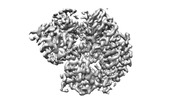

















 Z
Z Y
Y X
X


























